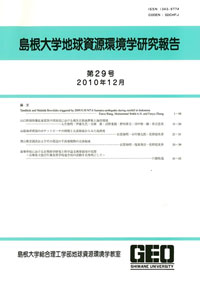島根大学総合理工学部地球資源環境学教室
ISSN:1343-9774

ダウンロード数 : ? 件
この文献の参照には次のURLをご利用ください : https://ir.lib.shimane-u.ac.jp/6436
島根大学地球資源環境学研究報告 25
2006-12-27 発行
島根県江島の更新世玄武岩と鳥取県弓ヶ浜砂州南東端粟島の中新世流紋岩のK-Ar年代
K-Ar ages of a Pleistocene basalt from Eshima, Shimane Prefecture and a Miocene rhyolite from Awashima, Yumigahama Sandbar, Tottori Prefecture
澤田 順弘
今井 雅浩
三浦 環
徳岡 隆夫
板谷 徹丸
ファイル
内容記述(抄録等)
Igneous activity in the Shinji Rift System related to opening of the Japan Sea began in the Early Miocene and continued through to the Pleistocene. New K-Ar ages have been determined for a Pleistocene basalt from a borehole at Eshima bridge and a Miocene rhyolite from Awashima, southern Yumigahama Sandbar. The Pleistocene basalt yielded a whole rock K-Ar age of 0.19±0.01 Ma. A biotite age of 17.48±0.40 Ma for the Miocene rhyolite indicates that it belongs to the Kawai Formation. The Eshima borehole shows that the Eshima-Daikonjima basalts were erupted on land, and that their base is now situated 60 meters beneath present-day sea level. This suggests that sea level at 0.19±0.01 Ma was at least 60 meters lower relative to that of the present day.
Other Article
PP. 49 - 59
